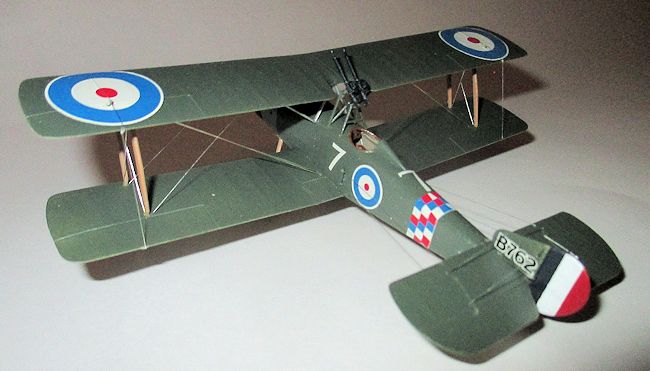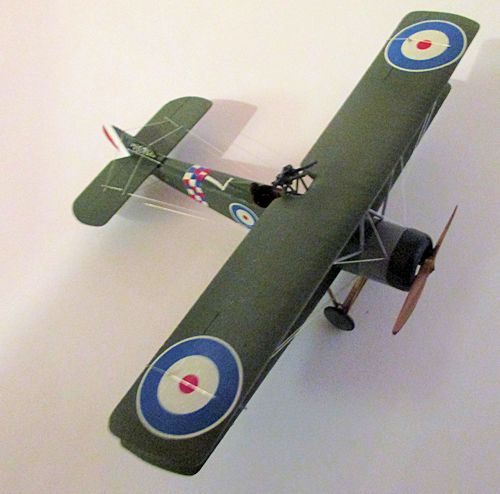
Eastern Express 1/72 Sopwith 1½ Strutter
| KIT #: | 72157 |
| PRICE: | $11.99 |
| DECALS: | One option |
| REVIEWER: | Brian Baker |
| NOTES: |
Very nice basic kit with other options available. |

| HISTORY |
The Sopwith 1 ½ Strutter was originally designed in late 1915 for the
Admiralty, and was a two seater powered by a 110 hp. Clerget 9Z
Rotary.
It was primarily of
wooden construction, and it appears that armament was a secondary
consideration.
When it first
appeared,
synchronization gear
finally became available, and the 1 ½ Strutter seems to be the first British
aircraft to have been equipped with this device.
The Royal Navy’s first use for the aircraft was long distance bombing
attacks, and these
 aircraft
were used in the first strategic bombing attacks in the history of warfare.
By 1916, the land battles had become serious, and the Royal Flying
Corps wanted the type for its own use.
In April, 1916,
RFC
Sopwiths were tested at Farnborough,
and the type was ordered into production for that service.
Demand was so great that additional contracts were placed with
Ruston- Proctor,
Vickers,
Wells, Morgan, and Hooper, and also Westland, Mann-Egerton and Fairey were
involved. About 1,439 were produced for the British.
The RNAS used more of the aircraft
that the RFC, but the surprising fact is that the French ordered 4,500 of
the type for use with its reconnaissance units, and these were produced in
France by French companies.
In
addition, American units were also equipped with the type.
U.S. Navy units used the type as an observation aircraft, some being
catapulted off the battleships Arizona,
Nevada,
Oklahoma,
and Pennsylvania.
Given the numbers of aircraft
produced, it is not surprising that many were exported after the war, to
countries such as Holland, Japan, Latvia, Brazil, Roumania, and Belgium.
The only surviving 1 ½ Strutter is on display in a military museum in
Brussels, Belgium.
A few
surplus planes were bought by American civilians, and one was on the U.S.
Civil register as late as 1930.
aircraft
were used in the first strategic bombing attacks in the history of warfare.
By 1916, the land battles had become serious, and the Royal Flying
Corps wanted the type for its own use.
In April, 1916,
RFC
Sopwiths were tested at Farnborough,
and the type was ordered into production for that service.
Demand was so great that additional contracts were placed with
Ruston- Proctor,
Vickers,
Wells, Morgan, and Hooper, and also Westland, Mann-Egerton and Fairey were
involved. About 1,439 were produced for the British.
The RNAS used more of the aircraft
that the RFC, but the surprising fact is that the French ordered 4,500 of
the type for use with its reconnaissance units, and these were produced in
France by French companies.
In
addition, American units were also equipped with the type.
U.S. Navy units used the type as an observation aircraft, some being
catapulted off the battleships Arizona,
Nevada,
Oklahoma,
and Pennsylvania.
Given the numbers of aircraft
produced, it is not surprising that many were exported after the war, to
countries such as Holland, Japan, Latvia, Brazil, Roumania, and Belgium.
The only surviving 1 ½ Strutter is on display in a military museum in
Brussels, Belgium.
A few
surplus planes were bought by American civilians, and one was on the U.S.
Civil register as late as 1930.
| THE KIT |
Cast in light grey soft styrene, this kit provides excellent interior and
exterior detail with little flash to be trimmed off.
The interior consists of a cockpit floor, rudder pedals, a control stick,
a seat and a cover for
 the cockpit.
It appears that a two seat kit is available, and that sufficient parts are
provided for the second cockpit.
Twin machine guns for a mounting ahead of the cockpit are supplied, as
this is the single seat zeppelin-interceptor variant, and the wings are molded
in two bottom components and one upper.
Struts are individual, and the inside cabane struts are finely reproduced
so alignment is better than with most biplane kits.
The engine and cowling are very detailed, and the whole thing goes
together easily.
The prop is glued
onto the crankshaft, and this looks realistic when done.
The landing gear consists of two “V” struts and a spreader bar, with the
wheels to be glued in position on the spreader bar tips.
the cockpit.
It appears that a two seat kit is available, and that sufficient parts are
provided for the second cockpit.
Twin machine guns for a mounting ahead of the cockpit are supplied, as
this is the single seat zeppelin-interceptor variant, and the wings are molded
in two bottom components and one upper.
Struts are individual, and the inside cabane struts are finely reproduced
so alignment is better than with most biplane kits.
The engine and cowling are very detailed, and the whole thing goes
together easily.
The prop is glued
onto the crankshaft, and this looks realistic when done.
The landing gear consists of two “V” struts and a spreader bar, with the
wheels to be glued in position on the spreader bar tips.
| CONSTRUCTION |
No construction information provided.
| COLORS & MARKINGS |
 Much of the painting can be done before the upper wing is mounted.
The upper surfaces should be a khaki green (dark green) while the
undersides should be linen color. The cabanes are, according to the
instructions, supposed to be painted aluminum color, while the main outer
wing struts should a wood brown color.
These can all be done before assembly.
Detailed color instructions are provided.
Much of the painting can be done before the upper wing is mounted.
The upper surfaces should be a khaki green (dark green) while the
undersides should be linen color. The cabanes are, according to the
instructions, supposed to be painted aluminum color, while the main outer
wing struts should a wood brown color.
These can all be done before assembly.
Detailed color instructions are provided.
The decals are well done and in register, and shouldn’t need a lot of trimming. Decals are provided for only one airplane, #7 , B762, of No. 78 Sqdn., during August, 1917.
| CONCLUSIONS |
 This is a very nice little kit, and I’m happy to have added it to my World War I
display.
Although the Burns Guide
lists other kits from Airframe, Classic, Czechmasters, Eduard, Flight assembly,
HR Model, Master Models, Merlin, Pegasus, and Toko, this offering is the first
one I’ve seen and been able to get a hold of. It may be a reissued Toko kit, but
whatever, the Eastern Express kit is an excellent little kit, and at the price,
a bargain if you like good kits of aircraft of this vintage.
Get one if you can find one.
Highly recommended.
This is a very nice little kit, and I’m happy to have added it to my World War I
display.
Although the Burns Guide
lists other kits from Airframe, Classic, Czechmasters, Eduard, Flight assembly,
HR Model, Master Models, Merlin, Pegasus, and Toko, this offering is the first
one I’ve seen and been able to get a hold of. It may be a reissued Toko kit, but
whatever, the Eastern Express kit is an excellent little kit, and at the price,
a bargain if you like good kits of aircraft of this vintage.
Get one if you can find one.
Highly recommended.
| REFERENCES |
The best source of information on this aircraft is the old Profile Publication
No.
121, which give a good outline
of the plane’s development and service life.
Numerous color drawings and photos provide ample information for
modelers. Other on-line references are also available, so there is no shortage
of information on this type.
June 2015
Copyright ModelingMadness.com. All rights reserved. No reproduction in any form without express permission from the editor.
If you would like your product reviewed fairly and fairly quickly, please contact the editor or see other details in the Note to Contributors.